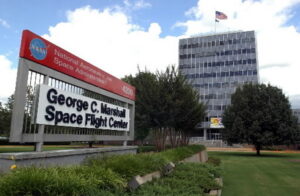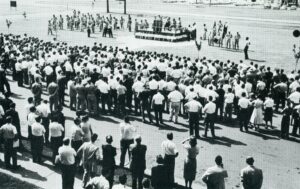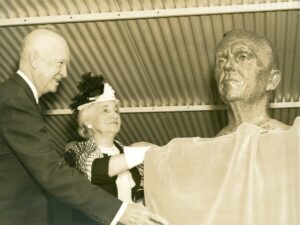 Fifty-five years ago next week during a quiet ceremony that formally transferred a facility from the military to a civilian agency, the United States Army Ballistic Missile Agency began operating as the George C. Marshall Space Flight Center. What caused this transfer and why name it after an Army general if it was no longer a military enterprise?
Fifty-five years ago next week during a quiet ceremony that formally transferred a facility from the military to a civilian agency, the United States Army Ballistic Missile Agency began operating as the George C. Marshall Space Flight Center. What caused this transfer and why name it after an Army general if it was no longer a military enterprise?
Two years earlier in July 1958, President Eisenhower signed the National Aeronautics and Space Act redefining the U. S. space program. This act gave the President the authority to transfer any facilities or duties to NASA. Later that year he used that authority in conjunction with the Huntsville, Alabama facility. He said “to strengthen the national space effort and provide for America’s changing requirements, I have concluded that the Army Ballistic Missile Agency can best serve the national interest as an integral part of NASA.”

Army Transfer July 1, 1960
A year later on December 18, 1959, Hugh Dryden of NASA wrote, “it has been suggested that the new Space Flight Center be given the name, Marshall Space Flight Center in honor of General George C. Marshall. This has seemed appropriate for many reasons. The mission of NASA is the scientific research in and exploration of space for peaceful purposes. The new center comes to NASA from the Army and its personnel have long been associated with the Army. It seems fitting therefore to honor a great military leader whose life was dedicated to the cause of peace, who initiated the Marshall Plan, who won the Nobel Peace Prize and who served our country as Secretary of State. The bestowal of his name on the new center would not only honor his character, his leadership and his dedication to public service but also serve as a reminder to those associated with the laboratory to follow his example.”
The new civilian director of the center, Dr. Wernher von Braun agreed. “Like General of the Army George C. Marshall was first recognized in war but later achieved world stature and lasting fame as a man of peace, our group was once part of the U.S. Army’s famed Army Ballistic Missile Agency and now our responsibilities have been turned away from the military and focused on fascinating problems of the exploration and scientific investigation of space.”
 Two months after the transfer of the facility, Mrs. Katherine Marshall and President Eisenhower dedicated the center. Mrs. Marshall unveiled the bust of General Marshall sculpted by Kalervo Kallio, a well-known Finnish sculptor. At the dedication, Eisenhower praised General Marshall:
Two months after the transfer of the facility, Mrs. Katherine Marshall and President Eisenhower dedicated the center. Mrs. Marshall unveiled the bust of General Marshall sculpted by Kalervo Kallio, a well-known Finnish sculptor. At the dedication, Eisenhower praised General Marshall:
“General Marshall was supremely endowed. He was a man of war, yet a builder of peace—forceful and dynamic as a leader, calculating and prudent in judgment, yet warmly regarded by his associates. He was selfless, indeed self-effacing, yet known and admired throughout the world. Though dominating in personal force, in action and thought he was humble and considerate.”
“I found him immune to discouragement, relentless in carrying the war to our enemy, and unsparing of himself in his leadership of the great forces he directed. But so profound was his devotion to the constructive works of peace—so outspokenly was he their advocate as Secretary of State—that he later became the symbol of renewed hope for scores of millions of suffering people through his great plan for Europe that will forever bear his name.”
“We, participating in this brief ceremony, agree with Sir Winston Churchill that, ‘succeeding generations must not be allowed to forget General Marshall’s achievements and his example.'”
“There are ways to do this that General Marshall would have prized far more than what we do here today. Thus we should carry forward the noble mission, ever striving to strengthen peace, ever advancing the cause of human liberty, ever doing our best to build a better life for all.”
“That is what George Marshall would wish of us today.”
“In this spirit, and with deep satisfaction in having shared in this tribute to a revered friend, I dedicate this, the George C. Marshall Space Flight Center. May this great center be ever worthy of its honored name.”
